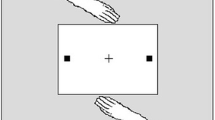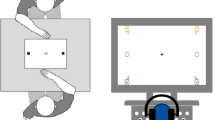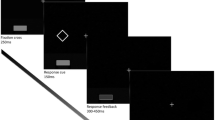Abstract
Although the inhibition of return (IOR) effect is primarily studied when people act individually, IOR is also observed in social environments where a person observes a partner’s response before executing their own response (social or sIOR). Specifically, an observer takes longer to initiate a response to a target at a location that another individual has just responded to than to another location. The present study was conducted to determine if sIOR emerges when two individuals execute different actions—one participant executed keypress responses and the other completed aiming movements to the same set of stimuli. The two conditions in the present experiment were designed to separate the effects of observing a co-actor’s target information from observing their subsequent response. In the Full Vision condition, observers saw both the target stimuli and the response of the partner. In the Partial Vision condition, observers witnessed the response of the partner, but did not see the target stimulus or any other potentially attention capturing event at the target location. It was found that, although sIOR emerged in the Full Vision condition, sIOR did not emerge in the Partial Vision condition. These and other previous findings on the impact of action goal on sIOR are discussed with reference to the potential contributions of attention and action co-representation mechanisms to the sIOR effect.



Similar content being viewed by others
Notes
In the present paper, a paired-alternating method was used in which participants execute two responses and then watch their partner execute two responses (i.e., AABBAABB…). As a consequence, individual trials (in which the person follows their own response) and joint trials (in which the person follows the action of their partner) are intermixed into the same blocks. In other studies, a straight-alternating approach has been used where participants alternate on each trial (i.e., ABABAB…). The latter straight-alternating approach may be preferred in some circumstances because it indexes the more interesting sIOR in isolation from the iIOR generated by one’s own actions. The present work aimed to assess both sIOR and iIOR and, as such, the decision was made to employ the paired-alternating approach.
References
Abrams, R. A., & Christ, S. E. (2003). Motion onset captures attention. Psychological Science, 14(5), 427–432.
Ariga, A., & Watanabe, K. (2009). What is special about the index finger?: The index finger advantage in manipulating reflexive attentional shift. Japanese Psychological Research, 51(4), 258–265.
Atamca, S., Sebanz, N., & Knoblich, G. (2011). The joint flanker effect: Sharing tasks with real and imagined co-actors. Experimental Brain Research, 211(3–4), 371–385.
Atkinson, M. A., Simpson, A., Skarratt, P. A., & Cole, G. G. (2014). Is social inhibition of return due to action co-representation? Acta Psychologica, 150, 85–93.
Bekkering, H., Wohlschläger, A., & Gattis, G. (2000). Imitation of gestures in children is goal-directed. Quarterly Journal of Experimental Psychology: Human Experimental Psychology, 53, 153–164.
Böckler, A., Knoblich, G., & Sebanz, N. (2011). Giving a helping hand: Effects of joint attention on mental rotation of body parts. Experimental Brain Research, 211(3–4), 531–545.
Brass, M., Bekkering, H., & Prinz, W. (2001). Movement observation affects movement execution in a simple response task. Acta Psychologica, 106(1), 3–22.
Carpenter, M., Akhtar, N., & Tomasello, M. (1998). Fourteen through18-month-old infants differentially imitate intentional and accidental actions. Infant Behavior and Development, 21, 315–330.
Cisek, P. (2007). Cortical mechanisms of action selection: The affordance competition hypothesis. Philosophical Transactions of the Royal Society B, 362(1485), 1585–1599.
Cole, G. G., Skarratt, P. A., & Billing, R.-C. (2012). Do action goals mediate social inhibition of return? Psychological Research, 76(6), 736–746.
Flanagan, J. R., & Johansson, R. S. (2003). Action plans used in action observation. Nature, 424(6950), 769–771.
Fogassi, L., Ferrari, P. F., Gesierich, B., Rozzi, S., Chersi, F., & Rizzolatti, G. (2005). Parietal lobe: From action organization to intention understanding. Science, 308(5722), 662–667.
Friesen, C. K., & Kingstone, A. (1998). The eyes have it! Reflexive orienting is triggered by nonpredictive gaze. Psychonomic Bulletin & Review, 5(3), 490–495.
Frischen, A., Loach, D., & Tipper, S. P. (2009). Seeing the world through another person’s eyes: Simulating selective attention via action observation. Cognition, 111(2), 212–218.
Graf, M., Reitzner, B., Corves, C., Casile, A., Giese, M., & Prinz, W. (2007). Predicting point-light actions in real-time. Neuroimage, 36, T22–T32.
Janczyk, M., , T.N., & Dolk, T. (2016). A role of action goals for social inhibition of return? Quarterly Journal of Experimental Psychology. doi:10.1080/17470218.2015.1112417
Kim, D., & Hommel, B. (2015). An event-based account of conformity. Psychological Science, 26, 484–489.
Klein, R. M. (2000). Inhibition of return. Trends in Cognitive Science, 4(4), 138–147.
Klein, R. M., & Hilchey, M. D. (2011). Oculomotor inhibition of return. In S. Liversedge, I. Gilchrist, & S. Everling (Eds.), Oxford handbook on eye movements (pp. 471–492). Oxford: Oxford University Press.
Klein, R. M., & MacInnes, W. J. (1999). Inhibition of return as a foraging facilitator in visual search. Psychological Science, 10(4), 346–352.
Massen, C., & Prinz, W. (2009). Movements, actions and tool-use actions: An ideomotor approach to imitation. Philosophical Transactions of the Royal Society of London. Series B, Biological sciences, 364(1528), 2349–2358.
Maylor, E. A., & Hockey, R. (1985). Inhibitory component of externally controlled covert orienting in visual space. Journal of Experimental Human Perception and Performance, 11(6), 777–787.
Neyedli, H., & Welsh, T. N. (2012). The processes of facilitation and inhibition in a cue-target paradigm: Insight from movement trajectory deviations. Acta Psychologica, 139, 159–165.
Ondobaka, S., de Lange, F. P., Newman-Norlund, R. D., Wiemers, M., & Bekkering, H. (2012). Interplay between action and movement intentions during social interaction. Psychological Science, 23(1), 30–35.
Ondobaka, S., Newman-Norlund, R. D., de Lange, F. P., & Bekkering, H. (2013). Action recognition depends on observer’s level of action control and social personality traits. PLoS One, 8(11), e81392.
Parkinson, J., Springer, A., & Prinz, W. (2011). Can you see me in the snow? Action simulation aids the detection of visually degraded human motion. Quarterly Journal of Experimental Psychology, 64(8), 1463–1472.
Parkinson, J., Springer, A., & Prinz, W. (2012). Before, during and after you disappear: Aspects of timing and dynamic updating of the real-time action simulation of human motions. Psychological Research, 76(4), 421–433.
Posner, M. I., & Cohen, Y. (1984). Components of visual orienting. In H. Bouma & D. G. Bouwhuis (Eds.), Attention and performance X (pp. 531–556). Hillsdale: Erlbaum.
Pratt, J., & Neggers, B. (2008). Inhibition of return in single and dual tasks: Examining saccadic, keypress, and pointing responses. Perception and Psychophysics, 70(2), 257–265.
Prinz, W. (2005). An ideomotor approach to imitation. In S. Hurley & N. Chater (Eds.), Perspectives on imitation: From neuroscience to social science (Vol. 1, pp. 141–156). Cambridge: MIT Press.
Ray, M., & Welsh, T. N. (2011). Response selection during a joint action task. Journal of Motor Behavior, 43(4), 329–332.
Rizzolatti, G., & Craighero, L. (2004). The mirror-neuron system. Annual Reviews in Neuroscience, 27, 169–192.
Rizzolatti, G., Riggio, L., & Sheliga, B. M. (1994). Space and selective attention. In C. Umilta & M. Moscovitch (Eds.), Attention and performance XV (pp. 231–265). Cambridge: MIT.
Sebanz, N., & Knoblich, G. (2009). Prediction in joint action: What, when, and where. Topics in Cognitive Science, 1(2), 353–367.
Sebanz, N., Knoblich, G., & Prinz, W. (2003). Representing others' actions: just like one's own? Cognition, 88, B11–B21.
Skarratt, P. A., Cole, G. G., & Kingstone, A. (2010). Social inhibition of return. Acta Psychologica, 134(1), 48–54.
Spence, C., Lloyd, D., McGlone, F., Nicholls, M. E. R., & Driver, J. (2000). Inhibition of return is supramodal: A demonstration between all possible pairings of vision, touch, and audition. Experimental Brain Research, 134(1), 42–48.
Springer, A., & Prinz, W. (2010). Action semantics modulate action prediction. The Quarterly Journal of Experimental Psychology, 63(11), 2141–2158.
Taylor, T. L., & Klein, R. M. (2000). Visual and motor effects in inhibition of return. Journal of Experimental Psychology: Human Perception and Performance, 26(5), 1639–1656.
Tipper, S. P., Lortie, C., & Baylis, G. C. (1992). Selective reaching: Evidence for action-centred attention. Journal of Experimental Psychology: Human Perception and Performance, 18(4), 891–905.
Tremblay, L., Welsh, T. N., & Elliott, D. (2005). Between-trial inhibition and facilitation in goal-directed aiming: Manual and spatial asymmetries. Experimental Brain Research, 160, 79–88.
Umilta, M. A., Kohler, E., Gallese, V., Fogassi, L., Fadiga, L., Keysers, C., & Rizzolatti, G. (2001). I know what you are doing: A neurophysiological study. Neuron, 31(1), 155–165.
Vesper, C., Butterfill, S., Knoblich, G., & Sebanz, N. (2010). A minimal architecture for joint action. Neural Networks, 23(8), 998–1003.
Villiger, M., Chandrasekharan, S., & Welsh, T. N. (2011). Activity of human motor system during action observation is modulated by object presence. Experimental Brain Research, 209(1), 85–93.
Welsh, T. N., Elliott, D., Anson, J. G., Dhillon, V., Weeks, D. J., Lyons, J. L., & Chua, R. (2005). Does Joe influence Fred’s action? Inhibition of return across different nervous systems. Neuroscience Letters, 385(2), 99–104.
Welsh, T. N., Lyons, J., Weeks, D. J., Anson, J. G., Chua, R., Mendoza, J. E., & Elliott, D. (2007). Within- and between-nervous system inhibition of return: Observation is as good as performance. Psychonomic Bulletin & Review, 14(5), 950–956.
Welsh, T. N., Manzone, J., & McDougall, L. M. (2014). Knowledge of response location alone is not sufficient to generate social inhibition of return. Acta Psychologica, 153, 153–159.
Welsh, T. N., McDougall, L. M., & Weeks, D. J. (2009a). The performance and observation of action shape future behaviour. Brain and Cognition, 71(2), 64–71.
Welsh, T. N., & Pratt, J. (2006). Inhibition of return in cue-target and target–target tasks. Experimental Brian Research, 174(1), 167–175.
Welsh, T. N., Ray, M., Weeks, D. J., Dewey, D., & Elliott, D. (2009b). Does Joe influence Fred’s action? Not if Fred has autism spectrum disorder. Brain Research, 1248, 141–148.
Welsh, T. N., & Weeks, D. J. (2010). Visual selective attention and action. In D. Elliott & M. A. Khan (Eds.), Vision and Goal-Directed Movement: Neurobehavioral Perspectives (pp. 39–58). Champaign: Human Kinetics.
Welsh, T. N., Neyedli, H. F., & Tremblay, L. (2013a). Refining the time course of facilitation and inhibition in attention and action. Neuroscience Letters, 554, 6–10.
Welsh, T. N., Wong, L., & Chandresekharan, S. (2013b). Factors that affect action possibility judgments: The assumed abilities of other people. Acta Psychologica, 143(2), 235–244.
Acknowledgments
This research was supported by a Discovery Grant and Undergraduate Student Research Award from the Natural Sciences and Engineering Research Council of Canada and an Early Researcher Award from the Ontario Ministry of Research and Innovation.
Author information
Authors and Affiliations
Corresponding author
Rights and permissions
About this article
Cite this article
Manzone, J., Cole, G.G., Skarratt, P.A. et al. Response-specific effects in a joint action task: social inhibition of return effects do not emerge when observed and executed actions are different. Psychological Research 81, 1059–1071 (2017). https://doi.org/10.1007/s00426-016-0794-x
Received:
Accepted:
Published:
Issue Date:
DOI: https://doi.org/10.1007/s00426-016-0794-x




